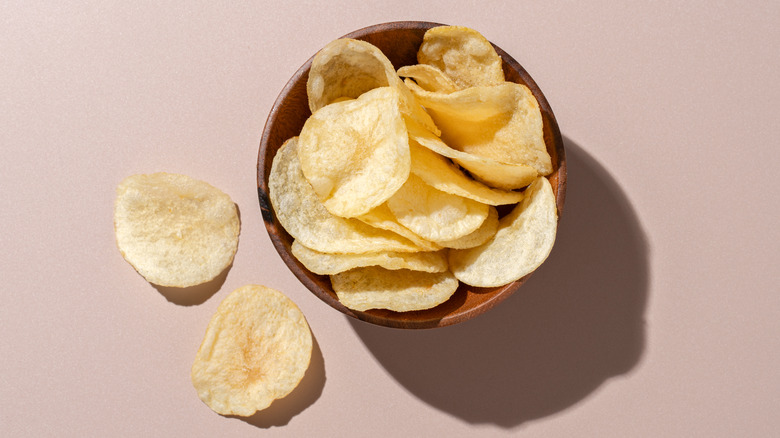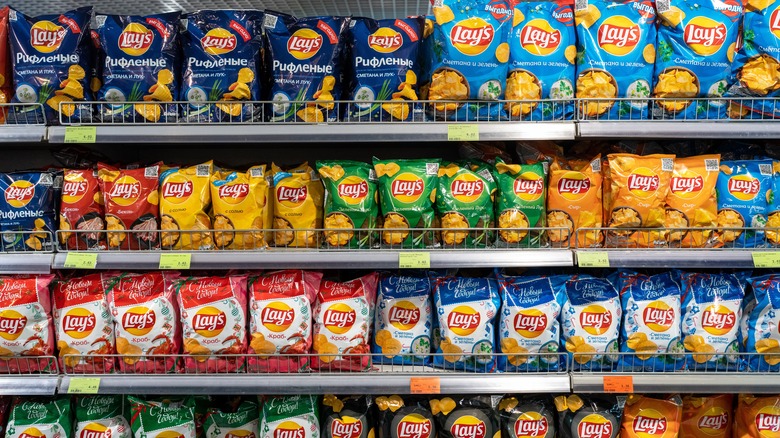Potato Chips Started Off As A Delicacy In Restaurants
We may receive a commission on purchases made from links.
Although well-known today as a mass-produced, beloved national snack, the beginnings of the American potato chip craze were far more gourmet. The apocryphal legend begins with railroad magnate Cornelius Vanderbilt dining at an upscale resort in Saratoga Springs in 1853. When he sent his fried potatoes back to the kitchen for being too thick, Chef George Crum (sometimes referred to by his birth name, George Speck) was furious. To express his sentiments to his picky customer, he sent back paper-thin potato cuts, fried in oil, and salted generously.
Unexpectedly, Vanderbilt loved them and the crunchy "Saratoga chips" became a hit in Upstate New York. Seven years later, Crum opened his own restaurant near Saratoga Lake with golden fried chips sitting on each table that catered to some of the biggest names of the time: Vanderbilts and railroad magnate, Jason (Jay) Gould.
Although playing an important role in the potato chip's introduction to the United States, Crum can't claim full glory as the first inventor. The earliest reference to potato chips came from the United Kingdom. William Kitchiner included a recipe for "Potatoes fried in slices or shavings" in his 1817 book, "The Cook's Oracle" (via The Museum of Crisps). Nonetheless, Crum's introduction of the potato chip to Upstate New York seems to be the stimulus for the food history that followed — and began the association of potato chips with the elite.
The commercialization of potato chips
Throughout the late 1800s in America, the potato chip was in vogue as a fancy restaurant delicacy. The 1900s brought several shifts in the tide of innovation and marketing that marked a new era for potato chips. In 1926, a Californian entrepreneur named Laura Scudder sold the chips in wax bags sealed with an iron, which boasted of keeping the chips fresh and crisp.
The following year, the invention of moisture-proof cellophane set the stage for the eventual mass production of the chip. It was then in the 1920s when Herman Lay began selling the chips out of his car to southern grocers, leading to Lay's becoming the first national potato chip brand in 1961.
By the 1950s, an Irish potato chip company Tayto had invented the first flavored chips (or 'crisps' as they are called across the pond). Cheese and onion was the debut flavor in 1954, leading to a boom of unexpected flavors across the potato chip market — such as Bolognese and crispy bacon.
The potato chip's full circle return to delicacy
Ironically, after many decades as humble sports game and vending machine fare, the potato chip is making somewhat of a return to its aristocratic roots. Don't be surprised to find sommeliers suggesting potato chips as the perfect pairing for champagne. High-end restaurants can be found serving homemade potato chips with canned conservas (seafood), smoked mussels, or something truly avant-garde like whipped coffee foam. In recent years, upscale restaurants like San Francisco's Lazy Bear have been experimenting with potato chip presentation — the Lazy Bear featuring a course of potato chips that was blended into a custard-like dish and served with caviar.
Caviar has been appearing just about everywhere and on everything as of late, but the expensive sturgeon roe and potato chips create an unrivaled pairing. In fact, you would be hard-pressed to find a caviar service nowadays that doesn't include potato chips. This unlikely marriage of the two is playing a large role in the potato chip's reincarnation as a restaurant delicacy.



